
Circus disciplines are the specialties of acrobats, involving physical virtuosity, risk and achievement. They are the source of the circus language, driving the development of circus arts through both the evolution of techniques and the invention of new apparatus. Circus disciplines also determine the aesthetics of the acrobatic body, and each offers its own range of circus gestures. They are grouped into categories according to the apparatus used and the skills and abilities required to perform them.
An ancestral discipline of strength and skill at the heart of circus arts, consisting of jumps, balancing acts and floor contortions. Of Greek origin, the term acrobatics means “one who walks on tiptoe”. Floor acrobatics disciplines include banquine, high bar, Russian bar, hand to hand and trampoline.
Acrobatic Chair
The acrobatic chair is straight and sturdy, enabling the acrobat to perform a variety of balancing and floor acrobatics. The acrobatic chair can be used on its own or in a stack. A circus discipline in which the acrobat uses many stacked chairs to perform various balancing acts on the supporting structure is known as a chair pyramid.
Banquine
Acrobatic discipline performed on the floor by two carriers who use their arms to propel an aerialist standing on their intertwined hands (the bench position). This propulsion allows the aerialist to perform acrobatic jumps to arrive either at his or her starting point, on the ground or on the bench of a second team of carriers.
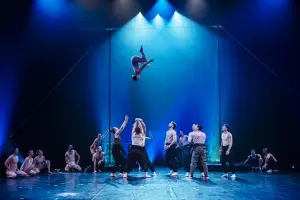
Spectacle Jusqu’au prochain moi, 2022
Chinese Hoops
This Chinese specialty consists of a set of wooden or metal hoops of varying diameters, stacked one on top of the other and balanced on the ground. Acrobats jump through these hoops while performing various acrobatics.

Frédéric Langevin, 2024
Chinese Pole
An apparatus of Asian origin, consisting of one or more metal poles fixed vertically to the ground, generally ranging from 3 to 9 meters in height, on which one or more acrobats climb to perform various acrobatic figures and jumps. The swinging pole is a derivative of the Chinese pole, with the same structure but suspended from the top by cables. The swinging pole enables the acrobat to add dynamism and variety to the figures in his or her act, thanks to the movement created by the pole’s oscillation.
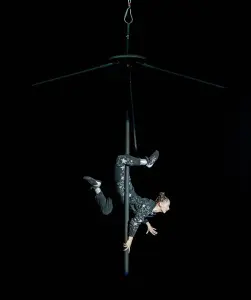
Maya Crutch, 2024
Contortion
The practice of extreme physical flexibility, dating back thousands of years, enables the contortionist to achieve positions of extreme stretching, bending and curving of the limbs. The practice of contortion can be divided into three categories: back dislocation, front dislocation and disarticulation. Back contortion is said to have fairground origins, while front contortion has Asian origins. A contortionist can perform any of these genres.

Spectacle Parades, 2023
Hand to Hand
A rigorous acrobatic discipline performed by two or more acrobats on the ground, in which the carrier and the acrobat perform figures of strength, balance, elevation and agility using the hands or head. There are two types of hand to hand: dynamic hand to hand and static hand to hand.
Dynamic hand to hand requires from the outset a much larger stage area and a faster rhythm for certain figures, as the carrier propels the acrobat with a push of the arms, allowing him or her to perform various acrobatic jumps to arrive either on the partner’s shoulders, on the shoulders of another carrier or on the ground. Various individual acrobatics, synchronized or not, are often added to the act. In some respects, when performed by more than two acrobats, dynamic hand to hand is akin to Banquine.
Static hand to hand is often performed in a small space, as the carrier and the acrobat perform only strength and balance movements that do not require major movements. The development of the balance and strength movements is presented in slow motion, to show the audience the acrobats’ rigor and stamina.

Clémence De Luca et Chase Levy, 2024
Icarian Games
A discipline derived from acrobatics and antipodism, in which the carrier lies on Trinka (a low, sloping triangular seat that provides support for the back), or on a cushion for Chinese and Mongolian acrobats, while the acrobat leaps into space with his feet, performing a variety of balancing tricks and somersaults. A second team of carriers and acrobats can join the act, performing a variety of somersaults that allow the acrobats to swap places.
Russian Bar
First used in 1958 in the circus by Boris Isaevy, this acrobatic discipline is performed on the ground with two carriers holding, either on the shoulder or at arm’s length, a flexible bar on which an acrobat stands and balances to perform various figures and somersaults.
Spring Board
A collective act based on a rocking board, in which the acrobats are propelled by one or two pushers jumping from the top of a pedestal, performing acrobatic jumps to arrive either on a mat on the floor or in a column on a carrier’s shoulders, or on a chair pole. This discipline has long been a specialty of Eastern European countries.
Teeterboard
A discipline derived from the jumping board, invented by artists in North Korea, consisting of a rocking board on which two acrobats sit to propel themselves in continuous turns while performing somersaults, twists and other acrobatic jumps.
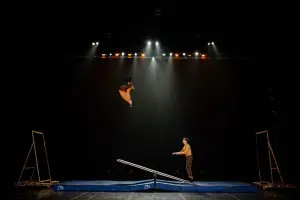
Léonard Meylan et Nathan Sterchi, 2023
Trampoline
A gymnastic discipline that first appeared in circus shows at the beginning of the 20th century, trampolines consist of an elastic fabric of variable size stretched by springs over a frame with legs, on which acrobats perform acrobatic figures and jumps. The trampoline is often used in conjunction with other acrobatic disciplines to accentuate the acrobats’ jumps.
Aerial acrobatics probably originated with the rope dancers of medieval fairs. Aerial acrobatics refers to all disciplines requiring the attachment of a suspended apparatus (bar, rope, trapeze, fabric, etc.). Unlike tightrope walkers and jumpers, aerial acrobats use the strength of their arms and hands to lift or move their own bodies or those of their partners. In aerial acrobatics, carriers or aerialists work in a fixed position, swinging or flying. Hoops, aerial rings, chains and straps are all part of aerial acrobatics.
Aerial Cradle
Fixed aerial apparatus made up of a rectangular, braced metal frame, often located under the big top dome, in which the carrier takes up position at the bend of the knees to allow the aerialist to perform various aerial acrobatics.
Aerial Hoop
Circular metal aerial apparatus of variable diameter, attached by one or two points, in which the acrobat performs acrobatic movements. The hoop can be fixed or swinging, used high up or close to the ground. When used close to the ground, the hoop enables the acrobat to perform foot propulsions, choreographies, speed variations and more.
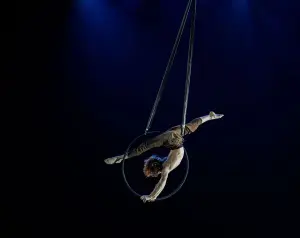
Jean Roubieu, 2023
Aerial Rings
Aerial apparatus, borrowed from gymnastics, consisting of two suspended metal circles. The annelist performs swings, turns, descents and balances in a stable or swinging manner.
Aerial Silks
Aerial discipline invented by Gérard Fasoli, composed of a large fabric folded in half to form two sections of fabric suspended vertically at a hook point, where the acrobat wraps and contorts himself or herself to perform various acrobatic tricks and figures. Like the straps, the fabric allows the acrobat to perform large rotations above the ring, adding to the gracefulness of the acrobat’s movements as he or she takes flight.

Arielle Gorodetskaya, 2024
Aerial Straps
Aerial acrobatics specialty of Asian origin, consisting of two parallel straps several meters long, along which the acrobat wraps and unwraps himself or herself with his or her wrists and arms to perform ascents or descents while performing, suspended, various figures and acrobatics of great strength. The straps can also be rotated over the ring, giving the acrobat remarkable grace as he or she climbs.

Zoe Schubert, 2023
Cloud Swing
An aerial discipline consisting of a slack rope attached at both ends to form a swing about 6 meters long, where the acrobat performs a series of suspensions, spins and other aerial acrobatics. Used by tightrope walkers in the 17th century, the invention of this discipline predates the trapeze.
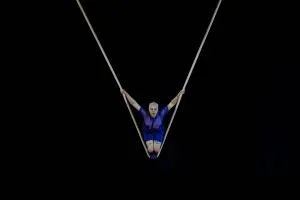
Nin Khelifa, 2023
Cordes Lisse
An aerial apparatus consisting of a 3 to 5 centimetre-diameter twisted or braided cotton rope arranged vertically, from which the acrobat performs various acrobatic tricks and figures. The rope can also be accompanied by a loop (a flexible sliding ring also known as a Staffe), which allows the acrobat to insert either his or her hand or foot, and then perform various rotational tricks thanks to the rotary thrust provided by an assistant on the ground.
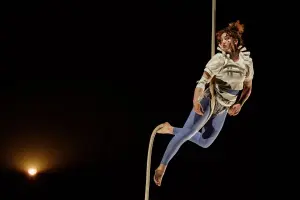
Flavie Beaulieu, 2023
Dance Trapeze
Discipline derived from the aerial hoop, using a simple trapeze suspended from a single point, in which the acrobat performs choreographed, acrobatic movements. Dance trapeze can be fixed or swinging, used high up or close to the ground. Dance trapeze close to the ground enables the acrobat to perform foot propulsions, choreographies, speed variations and more.

Manuel Gonzalo, 2024
Fixed Trapeze
Discipline using a single trapeze hung at various heights, where one or two acrobats perform figures and acrobatics without using the trapeze’s swinging movement. The fixed trapeze used by two acrobats is very similar to the aerial frame, with the carrier sitting on the trapeze in a position where the knees bend, allowing the acrobat to perform various aerial acrobatics.
Russian Cradle
Apparatus consisting of one or two frames equipped with platforms fixed to the ground at variable heights, facing each other, on which a carrier stands, attached by the waist to the platform. This position enables the carriers to propel the acrobat(s), who then perform various aerial acrobatics. This apparatus is sometimes added to installations for flying trapeze acts.

Maxime Blanckaert et Nathan Briscoe, 2017
Swinging Trapeze
Discipline using a single trapeze suspended at great height, requiring an amplitude of 14 meters, where the acrobat swings to perform various figures and acrobatics.
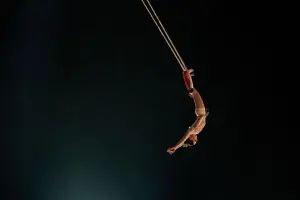
Malou Latrompette, 2024
Washington Trapeze
The bar of this metal trapeze is wide and balanced by two counterweights. Generally, its middle is hollowed out or has a round metal piece, called a round or plate, to enable head balances. The inventor of this apparatus was H.R. Keyes Washington (1838-1882).
As far back as antiquity, tightrope walkers performed in Greece and Rome. Balancing atop long bamboo poles was very popular in Asia. Balancing encompasses several disciplines and techniques performed on the ground, close to the ground or high above the ground, which involve controlling, stabilizing or holding the human body or objects still in a spectacular or original position by playing with the laws of gravity. Balance is a fundamental quality for circus artists, and the feat of physical balance uses the body of an acrobat – alone or with a partner – on a surface reduced to a minimum, a support, or one or more objects. The lower and higher the point of contact with the ground, the more spectacular the feat. Balancing involves a wide variety of disciplines, apparatus and accessories (bicycle, balancing ball, wire, slack wire, etc.).
Balancing
Ancestral acrobatic discipline, dating back to ancient times, which requires the equilibrist to perform various figures and acrobatics while balancing on his or her hands or head, either on the ground or on apparatus. The main apparatus used in balancing is called a cane, which consists of two metal rods of varying heights adorned with small blocks at their apexes to enable the equilibrist to rest his or her hands and perform balancing tricks.
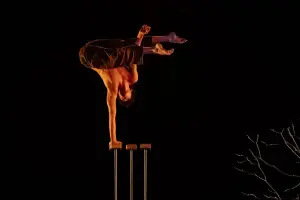
Thomas Parent, 2024
Balancing Ball
A large-diameter wooden or plastic sphere, up to 1.5 meters in diameter, on which the balancer performs acrobatics. Some jugglers also use the balancing ball to increase the difficulty of their act.
Bicycle
Discipline in which the acrobat performs acrobatic balances or jumps using the bicycle in a way that is original or distorted from its original function. In the nouveau cirque movement, the bicycle is sometimes used as an allegory for the horse.
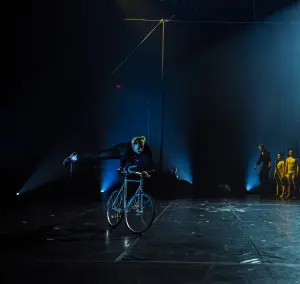
Spectacle Jusqu’au prochain moi, 2022
Cyr Wheel
Acrobatic disciple derived from the German Wheel and invented by Quebecer Daniel Cyr of Cirque Éloize, the Cyr Wheel consists of a simple metal circle inside which the acrobat moves under his or her own impulse, spinning incessantly while performing acrobatics. Unlike the German Wheel, the Cyr Wheel’s structure allows for greater rotation fluidity, accentuating the dynamism of the discipline.

Spectacle Jusqu’au prochain moi, 2022
Free Ladder
A simple ladder on which the acrobat climbs and maintains balance by constantly moving his or her hips, providing perpetual lateral movement and enabling him or her to perform ascents, balances and acrobatics at the top. A free ladder act can be combined with certain hand to hand or juggling tricks to increase the level of difficulty.

Spectacle Flujo, 2024
German Wheel
German in origin, this apparatus is made up of two large metal circles linked by small bars, inside which the acrobat sits and, by his or her own impulse, performs either lines or twirls while executing acrobatics.
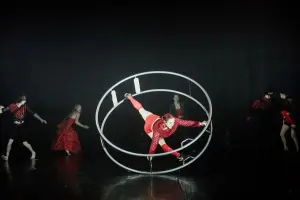
Spectacle I Dream, 2024
Rola-Bola
Invented by Frenchman Vasque in 1898, this discipline involves standing in balance on an unstable assembly of planks placed on rollers approximately 25 cm in diameter. Rola-Bola can be combined with other circus disciplines, such as juggling, hand to hand, etc.
Slack Rope
Derived from tight rope, but with the difference that the tension of the cable or rope is released to create a curve between the two posts, on which the acrobat oscillates and performs a series of figures, balances and jumps.
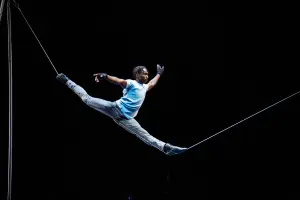
Antino Pansa, 2020
Tight Rope
Apparatus consisting of a wire rope stretched horizontally between two posts, on which the acrobat performs a series of figures, balances, dances, jumps and acrobatics. Tight rope acrobatics are generally performed at low heights, often 2 meters above the ground, as opposed to high wire acrobatics, which are performed at great heights.
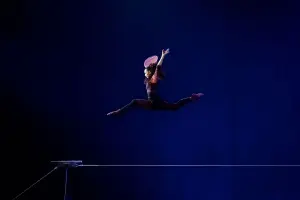
Rowan Allinson, 2024
Unicycle
Derived from the bicycle, this apparatus, invented around 1880 by the Italian Alessandro Scuri, consists of a single wheel with pedals and a saddle, on which the acrobat performs various acrobatics, balances and jumps. The unicycle is often combined with juggling.
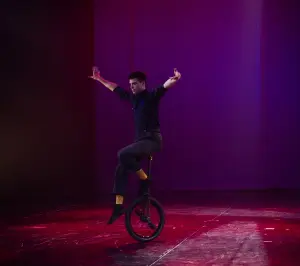
Esteban Immer, 202
Juggling is the leading discipline in the family of manipulative arts. An art of skill and agility dating back to Antiquity, juggling is practiced individually or in groups, and consists in swinging several props of all kinds (rings, balls, pins, etc.) in the air or on the ground, without dropping them, and throwing them again as the juggler(s) catch them. Juggling is frequently performed in combination with another circus discipline, such as unicycle, tight wire, Rola-bola, etc. Sub-categories of juggling can be identified, such as balance juggling, which involves balancing various objects (bowls, glasses, balloons, etc.) often stacked on the head, forehead or feet.
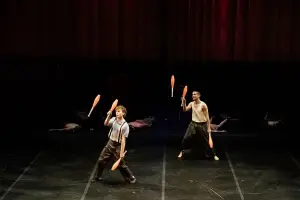
Tomber, en amour, 2024
Antipodism
Ancient juggling discipline practised among the Aztecs in particular. Once the juggler is lying on a Trinka (a very low, inclined triangular seat that supports the back), he juggles with his feet and various accessories such as rollers, barrels, mats and other objects.
Diabolo
A juggling discipline of Chinese origin, derived from the spinning top, performed with two sticks connected by a taut wire, which is used to slide the diabolo(s), double-isosceles, spool-shaped objects that the juggler spins and then propels through the air, making them perform various trajectories and twirls. The name refers to the noise the air makes as it rushes through the coil(s), a “devil’s noise” as it was called in the 18th century.
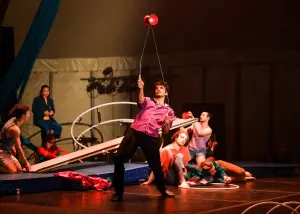
Spectacle Voir l’Ennui en rose, 2023
Flower Sticks
A juggling speciality popularized in the early 19th century by Indian artists Medua and Mooty Samme, which consists of swinging a stick, measuring around 80 centimetres and tapered at the center, between two wands.
Originating in pre-Shakespearean English comedy, the clown was originally a country buffoon comic character, an equestrian and acrobatic burlesque, before becoming a general comic and grotesque character in pantomime and circus shows. The art of clowning involves dramatic acting, mime, comedy and burlesque to create sketches that make the audience laugh. The first famous pantomime clown was Joey Grimaldi (1778-1837).
Towards the end of the eighteenth century, after the war, demobilized military cavalrymen and the ease of acquiring horses used to difficult conditions on the battlefield encouraged the popularity of spectacular horseback riding, which contributed to the birth of the classical circus. The equestrian arts involve working with one or more horses: dressage, academic horsemanship, acrobatics and more. Some equestrian disciplines, such as carousel, haute école and garrocha, require the rider to sit on the horse, while others, such as acrobatics and Hungarian post, require the acrobat to stand on the horse as it gallops along. Freedom acts feature horses without saddle or harness, performing a choreography directed by their trainer.
Discover fantastic books on :
© Please note that this history and chronology of the circus arts is an original intellectual creation that falls within the scope of copyright protection. Any reproduction, adaptation, translation and/or modification, in whole or in part, or transfer to another site is forbidden without the prior authorization of the National Circus School.